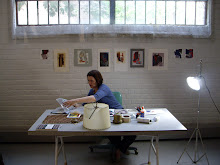Fiona
Halse’s series of large abstract paintings are concerned with the visceral. The
marks and structure within Halse’s work derive from the architectonic and
relates to the human figure’s internal feeling. These
works are linked with Tachist and Lyrical Abstraction traditions and intuitive,
lateral approaches to picture making are embraced. Her work values drawing, formalism
and affective composition, but she also seeks to capture passages in space
where the subconscious and unconscious can be transcribed. Halse has an
interest in metaphoric form and how this can be transferred through the hand,
materials and through praxis and this is evident in the texture and mark making
in her work. Abstraction to Halse is an
idealised state, and form can be a summarised essence that is stripped and
re-discovered.
These
large paintings connect with the viewer physically and forms replicate
structures that evoke the sense of a human body and there is an offering to the
viewer to enter through virtual pictorial space. But often spaces become closed, passages
vague, dense, and saturated with colour. Halse’s space is private and
ambiguous. A series of black paintings
preceded the works in this exhibition and there are still traces of scaffold,
black marks and spaces that have been found, moved, erased and
re-discovered.
Whilst
there are several large paintings on exhibition, there will also be a selection
of small works on paper and collages created in two arts residencies in Berlin.
Exhibition
Details:
Exhibition: 8 - 25 February 2017
Location: Stephen Mc Laughlan Gallery
Address: Level 8, Room 16, Nicholas Building 37, Swanston
Street, Melbourne, Australia
Hours:. Wednesday - Friday: 1pm - 5pm; Saturday: 11am - 5pm
Opening: Saturday 11 February, 2pm
-5pm
Web: www.stephenmclaughlangallery.com.au
Email:
st73599@bigpond.net.au
Phone: 0407
317 323
Installation views of Exhibition:
Installation views of Exhibition:
Details of paintings:
Collages:
Video:
































